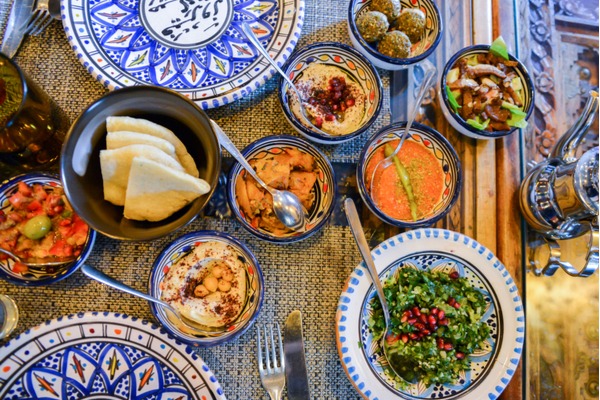One cuisine that is the underdog of all the cuisine family is the middle eastern cuisine. This lesser-known cuisine is from various countries and people of the Middle East. Well, as I am writing this,
One cuisine that is the underdog of all the cuisine family is the middle eastern cuisine. This lesser-known cuisine is from various countries and people of the Middle East. Well, as I am writing this, I got to know that February is the Middle Eastern cuisine month, this marvellous place where these amazing countries form part of. Derived from different cultures, such as Arab, Iranian, Jewish, Assyrian, Azerbaijani, Armenian, Georgian, Kurdish, and Turkish, this cuisine is all about discovering different countries in a single platter. It is believed that Middle eastern cuisine is growing to be one of the most popular and fastest growing ethnic cuisines around the world.
Middle Eastern is considered to be one of the models for a healthy eating lifestyle as there is the use of olive oil, fresh vegetables, legumes, and grilled meats. These all combined are the keys to a healthy diet. It is also noticed that people with the Alzheimer’s disease and cancer are lesser in numbers because of their Mediterranean diet.
Formerly known as the Fertile Crescent, the middle eastern includes the regions of Tigris, Euphrates, Sumeria, Akkad, Assyria, and Babylonia. This place is known for where the wheat was first cultivated, followed later by barley, pistachios, figs, pomegranates, dates, and other regional staples. It is also believed that fermentation was discovered here to leaven bread and make beer. It is probably mentioned in the earlier recipes that are conserved in a safe place.
Many elements of Middle Eastern cuisine have become solidly mainstream including Pita, hummus, falafel, chickpeas, kebabs, baklava, yogurt, honey, pistachios, feta—the list goes on. Other dishes and elements have enjoyed significant focus over the past few years such as shakshuka, shawarma and ancient grains.
That said, Middle Eastern cuisine does not come without some baggage, which has slowed its growth as a global cuisine in the U.S. Chief among these issues is the often negative, conflict-filled news American consumers are exposed to. Thankfully, consumers seem to be looking past this to explore and experience the amazing flavours and dishes that come from this culturally rich region.

Of course, it’s important to understand there is no cuisine common to the entire Middle East, which is made up of almost 20 countries, though from a flavour-theme perspective, you can expand that further afield to include countries in North Africa and farther east into Afghanistan and Pakistan.
The culinary differences country-by-country, and even region-by-region within some of those countries, will be more important in American menu development farther down the line. For now, the focus is on raising awareness and increasing consumer comfort within the broader umbrella of Middle Eastern cuisine.
Five Pathways to the Middle East
So how can operators work Middle Eastern cuisine into their menu innovation strategies? Options abound, with these five offering some of the best opportunity for translation:
1. Gateway Flavours
To create Middle Eastern inspired or influenced dishes, many of the ingredients that may be featured are familiar to consumers such as pistachios, chickpeas, couscous and tahini, and others may not be familiar, but are intuitive, such as rosewater and pomegranate molasses. Other ingredients can lend interest without pushing too hard against consumers’ comfort zones including preserved lemons, cardamom, sumac and hyssop, an aromatic herb with hints of mint, anise, thyme and rosemary. Add one or more of these flavours to create unexpected twists to more familiar sauces/dips, beverages, appetizers or entrées.

2. Spice Blends
The Middle East certainly didn’t invent spice blends but it has, arguably, elevated the concept to an art form. Spice blends from the Middle East range from dry blends to more pesto-style sauces, but all focus on flavour-rich ingredients that are well-balanced and impactful ingredients. Consider introducing dukkah, baharat, s’chug and za’atar as high-impact accents in shareables, burgers, tacos, wings, and more.
3. Spreads, Dips, Sauces
As with spice blends, the Middle East boasts fantastic spreads and dips that can offer operators a canvas upon which to innovate. Though hummus is the most familiar within this category, others include baba ganoush, muhammara, and kashke bademjan. In this era of interesting shareables, it’s a great time to dig into these flavourful, wholesome ingredients.
4. Beverages
Many consumers find it safest to experiment with beverages. In fact, many of the most innovative beverages to hit the U.S. market are from or inspired by international cuisines. To that end, consider limonana (mint lemonade, sometimes served frozen), qamar al-din (apricot juice or nectar-based beverage), leben (fermented milk beverage), salep (hot milk and cinnamon, thickened with salep flour), qishr (hot beverage made from coffee bean husks and ginger) and Turkish coffee. As non-alcoholic beverages hit their stride, any of these Middle Eastern options would create a compelling offering.

5. Breads, Cheeses and More
Adding entire items from Middle Eastern cuisine may be a bit more daunting for some operators, with the viability of these driven by the degree to which its patrons experiment. Starting with the basics such as bread (barbari – thick Iranian flatbread), taboon/ laffa (flatbread cooked in a taboon oven), lavash (soft thin flatbread), markook/saj (very thin unleavened flatbread),) or cheese such as halloumi can begin to break the ice.
Many other items may have unfamiliar names but have nothing truly unfamiliar to consumers such as khachapuri (cheese-filled bread), tahdig (crispy or scorched rice), tabbouleh (vegetable salad of parsley, tomatoes, mint, onion, and bulgar though other grains may be substituted), fatayer (meat pie made either with phyllo or dough), bourekas (crispy savoury filled pastries) and moussaka (eggplant-based layered dish usually including ground meat).
If you are looking for authentic Middle Eastern cuisine in Melbourne, VIC, then ARZ Lebanese Cuisine is your to go place. As a family operated restaurant, they offer traditional Lebanese food and a wide range of other specialities.

